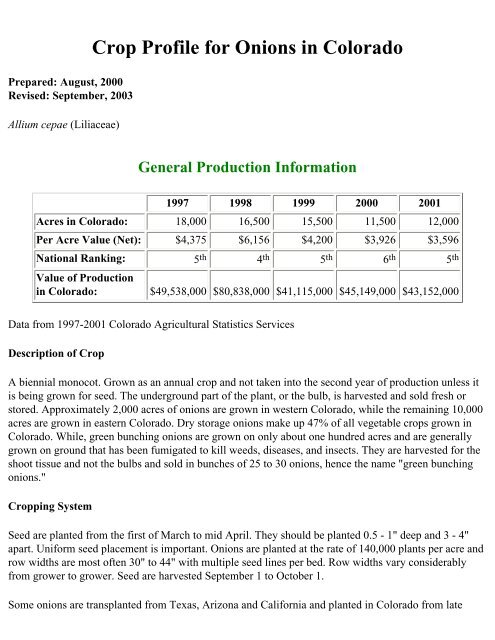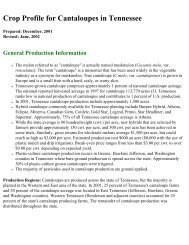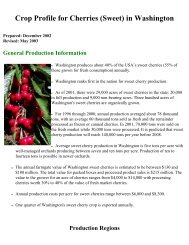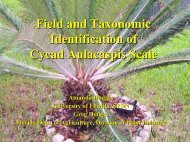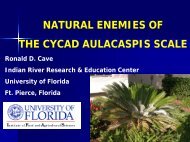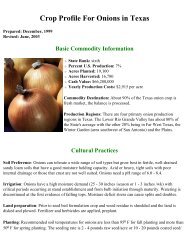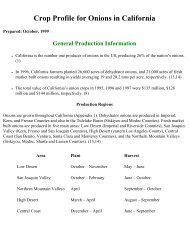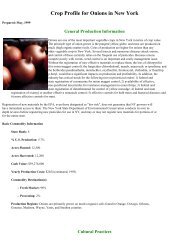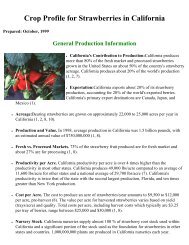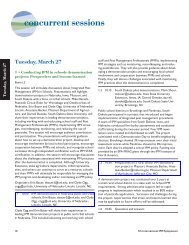Crop Profile for Onions in Colorado - Regional IPM Centers
Crop Profile for Onions in Colorado - Regional IPM Centers
Crop Profile for Onions in Colorado - Regional IPM Centers
You also want an ePaper? Increase the reach of your titles
YUMPU automatically turns print PDFs into web optimized ePapers that Google loves.
Prepared: August, 2000<br />
Revised: September, 2003<br />
Allium cepae (Liliaceae)<br />
<strong>Crop</strong> <strong>Profile</strong> <strong>for</strong> <strong>Onions</strong> <strong>in</strong> <strong>Colorado</strong><br />
General Production In<strong>for</strong>mation<br />
1997 1998 1999 2000 2001<br />
Acres <strong>in</strong> <strong>Colorado</strong>: 18,000 16,500 15,500 11,500 12,000<br />
Per Acre Value (Net): $4,375 $6,156 $4,200 $3,926 $3,596<br />
National Rank<strong>in</strong>g: 5th 4th 5th 6th 5th Value of Production<br />
<strong>in</strong> <strong>Colorado</strong>: $49,538,000 $80,838,000 $41,115,000 $45,149,000 $43,152,000<br />
Data from 1997-2001 <strong>Colorado</strong> Agricultural Statistics Services<br />
Description of <strong>Crop</strong><br />
A biennial monocot. Grown as an annual crop and not taken <strong>in</strong>to the second year of production unless it<br />
is be<strong>in</strong>g grown <strong>for</strong> seed. The underground part of the plant, or the bulb, is harvested and sold fresh or<br />
stored. Approximately 2,000 acres of onions are grown <strong>in</strong> western <strong>Colorado</strong>, while the rema<strong>in</strong><strong>in</strong>g 10,000<br />
acres are grown <strong>in</strong> eastern <strong>Colorado</strong>. Dry storage onions make up 47% of all vegetable crops grown <strong>in</strong><br />
<strong>Colorado</strong>. While, green bunch<strong>in</strong>g onions are grown on only about one hundred acres and are generally<br />
grown on ground that has been fumigated to kill weeds, diseases, and <strong>in</strong>sects. They are harvested <strong>for</strong> the<br />
shoot tissue and not the bulbs and sold <strong>in</strong> bunches of 25 to 30 onions, hence the name "green bunch<strong>in</strong>g<br />
onions."<br />
<strong>Crop</strong>p<strong>in</strong>g System<br />
Seed are planted from the first of March to mid April. They should be planted 0.5 - 1" deep and 3 - 4"<br />
apart. Uni<strong>for</strong>m seed placement is important. <strong>Onions</strong> are planted at the rate of 140,000 plants per acre and<br />
row widths are most often 30" to 44" with multiple seed l<strong>in</strong>es per bed. Row widths vary considerably<br />
from grower to grower. Seed are harvested September 1 to October 1.<br />
Some onions are transplanted from Texas, Arizona and Cali<strong>for</strong>nia and planted <strong>in</strong> <strong>Colorado</strong> from late
March to the end of April. If they are planted any earlier, cool weather may <strong>in</strong>duce them to produce seed<br />
stalks <strong>in</strong>stead of marketable onion bulbs.<br />
When us<strong>in</strong>g transplanted onions, the field must be furrowed and pre-irrigated or irrigated immediately<br />
after transplant<strong>in</strong>g occurs. Transplants are planted by hand as well as by mechanical means. Transplants<br />
should be carefully <strong>in</strong>spected <strong>for</strong> absence of diseases and <strong>in</strong>sect pests. Transplants are harvested August<br />
1 to September 1.<br />
<strong>Onions</strong> can be successfully rotated with the follow<strong>in</strong>g crops: sweet corn, field corn, alfalfa, potatoes, dry<br />
beans, melons, sugarbeets and small gra<strong>in</strong>s. It is better to plant small gra<strong>in</strong>s be<strong>for</strong>e onions <strong>in</strong>stead of<br />
large rooted-crops (e.g., alfalfa and corn) to avoid potential debris problems <strong>in</strong> the seed bed.<br />
When plant<strong>in</strong>g onions, care should always be taken to avoid temperature and moisture extremes, fertility<br />
imbalances, soil alkal<strong>in</strong>ity, high salt concentrations (onions are very sensitive to sal<strong>in</strong>ity), poor dra<strong>in</strong>age,<br />
and air pollution. M<strong>in</strong>imal soil compaction is also favorable. Cover crops are often planted <strong>in</strong> the fall or<br />
early spr<strong>in</strong>g to protect onion ground from w<strong>in</strong>d erosion.<br />
<strong>Onions</strong> require high amounts of water. Adequate irrigation is needed every 5 - 7 days dur<strong>in</strong>g warm<br />
summer to fall weather. <strong>Onions</strong> grown on sandy soil will require more frequent irrigation. Irrigation<br />
stops 7 - 10 days be<strong>for</strong>e onion bulbs are removed from the ground to allow the crop to mature. Furrow<br />
irrigation systems are common and drip irrigation is be<strong>in</strong>g adapted <strong>in</strong> many regions as well. Spr<strong>in</strong>kler<br />
irrigation is used to a lesser extent.<br />
<strong>Onions</strong> are harvested when 80% of their tops have fallen over and yellowed and the necks have dried<br />
down. Bulbs <strong>in</strong>tended <strong>for</strong> braid<strong>in</strong>g or fresh markets are harvested at an earlier stage. <strong>Onions</strong> that are<br />
slow to mature are undercut with a cutter bar which breaks roots and lifts the bulbs. Such bulbs are<br />
usually ready to harvest with<strong>in</strong> seven to 10 days of undercutt<strong>in</strong>g.<br />
Storage onions are harvested when 75 - 80% of the tops are down. This occurs around September 15.<br />
The root systems are severed, then the onions are allowed to cure until the tops have thoroughly dried.<br />
To avoid diseases, the neck area should be thoroughly dried and the onions should be blown with<br />
ambient to warm air until the cur<strong>in</strong>g process is complete. Optimal storage temperatures are 35 - 40 F<br />
with 65 - 70% relative humidity.<br />
Other Pesticides-<br />
Pesticide: maleic hydrazide (Clean <strong>Crop</strong> Maleic Hydrazide HC)<br />
● Use: Growth Regulator (control sprout<strong>in</strong>g)<br />
● Use Data:<br />
1997 = rate used- 1.53 lb ai/A<br />
30% of total acres treated
2001 = rate used- 2.00 lb ai/A<br />
60% of total acres treated<br />
Pesticide: metam sodium (Clean <strong>Crop</strong> Metam Sodium)<br />
● Use: General Soil Fumigant<br />
● Target Pests: Controls soilborne diseases and Supression of various weeds<br />
● Use Data:<br />
1992 = rate used- 172 lb ai/A<br />
4% of total acres treated<br />
Location of Production<br />
Southeast- Arkansas<br />
Valley (25% of production)<br />
Otero, Pueblo, Bent, Prowers, Baca (2003)<br />
Northwest<br />
Boulder, Larimer,<br />
Northeast- (55% of<br />
production)<br />
Kit Carson, Logan,<br />
Morgan, Phillips,<br />
Sedgwick, Weld,<br />
Wash<strong>in</strong>gton, Yuma<br />
Southwest- Western<br />
Slope (20% of<br />
production)<br />
Delta, Mesa, Montrose,<br />
Ouray, Dolores,<br />
Montezuma<br />
Note: Shaded boxes <strong>in</strong>dicate counties where the crop is grown. Regions have been del<strong>in</strong>eated by<br />
Interstates I-70 and I-25.
Insect Pests<br />
Key Insects<br />
Onion Thrips and Western Flower Thrips, Thrips tabaci and Frankl<strong>in</strong>iella occidentalis Thrips are<br />
m<strong>in</strong>ute <strong>in</strong>sects that feed on tender plant tissue. They rasp the tissue and dra<strong>in</strong> the exud<strong>in</strong>g sap, caus<strong>in</strong>g<br />
stunted and de<strong>for</strong>med plants. Thrips are usually a pest concern <strong>in</strong> seedl<strong>in</strong>g plants but may attack plants<br />
<strong>in</strong> any stage. Insecticides should be applied when thrips are present and plants show damaged term<strong>in</strong>al<br />
buds and cupp<strong>in</strong>g of the leaves. Thrips are also vectors <strong>for</strong> IYSV, a virus which emerged <strong>in</strong> 2001.<br />
Resistance issues <strong>in</strong> thrips reduce possible control tactics. In <strong>Colorado</strong>, thrips have developed resistance<br />
to lambda-cyhalothr<strong>in</strong> <strong>for</strong>mulations and pyrethroids. Methomyl and oxamyl are effective <strong>in</strong>secticides <strong>for</strong><br />
both the Western slope and the East side of the Rockies and work best with crop oils or surfactants.<br />
Lambda-cyhalothr<strong>in</strong> is only effective aga<strong>in</strong>st onion thrips on the Eastern side of the Rockies.<br />
Aphids, Family: Aphididae<br />
Additional Insects<br />
Aphid life cycles vary with species. Aphids are small, soft-bodied <strong>in</strong>sects found s<strong>in</strong>gly or <strong>in</strong> clusters on<br />
stems or on the undersides of leaves. Aphids overw<strong>in</strong>ter as eggs and adults. The t<strong>in</strong>y aphids hatch <strong>in</strong> the<br />
spr<strong>in</strong>g, mature rapidly and give birth, without mat<strong>in</strong>g, to liv<strong>in</strong>g young. Mature aphids fly to cultivated<br />
crops dur<strong>in</strong>g the spr<strong>in</strong>g and summer where they start new colonies. Only females are produced dur<strong>in</strong>g<br />
the summer and with their rapid rate of reproduction, it is possible <strong>for</strong> large numbers to develop <strong>in</strong> a<br />
short period of time. They may be a problem throughout the season. As cool weather approaches <strong>in</strong> the<br />
fall, both males and females are produced. The females then mate and lay fertile eggs that overw<strong>in</strong>ter.<br />
Aphids attack the leaves, blossoms, pods, and other parts of their host plants, suck<strong>in</strong>g plant juices<br />
through their t<strong>in</strong>y needle-like beaks. Heavily <strong>in</strong>fested plants become stunted and do not produce normal<br />
crops. Migrat<strong>in</strong>g aphids also transmit several important plant diseases such as onion yellow dwarf virus.<br />
Leafhoppers: Beet Leafhoppers and Potato Leafhoppers, Circulifer tenellus and Empasca fabae<br />
Beet leafhoppers feed on the undersides of leaves. Severe <strong>in</strong>festation, a rare occurrence, can cause leaf<br />
cupp<strong>in</strong>g and discoloration. Adult beet leafhoppers are pale green, active and 0.13" long. There are three<br />
or more generations per year, and the <strong>in</strong>sect can be found throughout the grow<strong>in</strong>g season. Hot, dry<br />
conditions favor development of this <strong>in</strong>sect, which vectors beet curly top virus. Control of beet<br />
leafhopper generally is not recommended. The potato leafhopper can be a serious problem early <strong>in</strong> the<br />
season. It overw<strong>in</strong>ters <strong>in</strong> the Gulf Coast area, and its migration <strong>in</strong>to this region usually occurs <strong>in</strong> too low<br />
of numbers and too late <strong>in</strong> the season to cause serious damage. The potato leafhopper is a wedge shaped,<br />
green <strong>in</strong>sect with six white spots on the prothorax. The leafhopper <strong>in</strong>jects a tox<strong>in</strong> dur<strong>in</strong>g feed<strong>in</strong>g that
damages the plant and results <strong>in</strong> leaf discoloration and stunt<strong>in</strong>g.<br />
Leafm<strong>in</strong>ers, Liriomyza huidobrensis<br />
Leafm<strong>in</strong>ers are sh<strong>in</strong>y, black flies, 0.04 - 0.12" <strong>in</strong> size, with yellow mark<strong>in</strong>gs. The leafm<strong>in</strong>er overw<strong>in</strong>ters<br />
<strong>in</strong> the soil <strong>in</strong> the pupal stage. Adult flies will emerge <strong>in</strong> May and seek out onions on which to lay their<br />
eggs. The adults are gray and smaller and th<strong>in</strong>ner than a house fly. The larvae are white maggots and are<br />
always present <strong>in</strong> the m<strong>in</strong>e <strong>in</strong>side the leaf. Females puncture the leaf to feed on plant sap and to lay their<br />
eggs with<strong>in</strong> the leaf tissue. When the eggs hatch, larvae feed on the area between the upper and lower<br />
leaf surfaces. Larval development with<strong>in</strong> the leaf lasts 7 - 10 days. Follow<strong>in</strong>g this period, the maggots<br />
move to the soil and pupate. The pupal period lasts <strong>for</strong> 2 - 3 weeks, after which the flies emerge to beg<strong>in</strong><br />
a new generation. While the larvae are small, they create narrow, w<strong>in</strong>d<strong>in</strong>g tunnels <strong>in</strong> the leaves that are<br />
visible as water-soaked or whitish areas. As the larvae <strong>in</strong>crease <strong>in</strong> size and <strong>in</strong> feed<strong>in</strong>g requirements, the<br />
feed<strong>in</strong>g area appears as large irregular blotches on the leaves. These large leaf m<strong>in</strong>es will dry up and<br />
darken, giv<strong>in</strong>g the plant a very ragged appearance. The primary damage caused to onions by leafm<strong>in</strong>ers<br />
is cosmetic. To m<strong>in</strong>imize pest problems, it is advisable to plant onions away from lettuce, celery and<br />
sp<strong>in</strong>ach fields, as they are also susceptible. It may also be necessary to allow a fallow period between<br />
harvest<strong>in</strong>g an <strong>in</strong>fected crop and plant<strong>in</strong>g other, susceptible plants <strong>in</strong> the same field.<br />
Maggots, Delia spp.<br />
Maggots are small and cream colored, crawl downwards on the plant, stay<strong>in</strong>g beh<strong>in</strong>d the leaf sheath,<br />
subsequently burrow<strong>in</strong>g <strong>in</strong>to the bulb of the onion. They feed ma<strong>in</strong>ly at the base of the onion. Feed<strong>in</strong>g<br />
can kill smaller bulbs, and create tunnels, or cavities, <strong>in</strong> the larger bulbs - some of which have more than<br />
one maggot <strong>in</strong> them at a time. Feed<strong>in</strong>g wounds often cause bulbs to rot and sprout while <strong>in</strong> storage.<br />
Flabby and off color (yellowish) plants are <strong>in</strong>dicative of onion maggot attacks. Insecticides such as<br />
chlorpyrifos are most effective when applied at plant<strong>in</strong>g to kill larval stages. Adult maggots primarily<br />
feed on field edges and rarely stay <strong>in</strong> the field. They return to the field <strong>for</strong> egg lay<strong>in</strong>g.<br />
Cultural Controls<br />
Key Insect Management Strategies<br />
Ensur<strong>in</strong>g a crop rotation of 3 - 4 years, proper and accurate irrigation, and proper plant<strong>in</strong>g density<br />
m<strong>in</strong>imizes pest problems. Thrips are an emerg<strong>in</strong>g issue. There may already be resistance develop<strong>in</strong>g.<br />
Insecticides -<br />
Pesticide: chlorpyrifos (Lorsban 4E)<br />
● Target Pests: Onion Maggot
● Recommended rate: 0.50 fl oz ai/1,000 row ft (1.1 fl oz /1,000 row ft)<br />
Pesticide: chlorpyrifos (Lorsban 15G)<br />
● Target Pests: Onion Maggot<br />
● Recommended rate: 0.55 fl oz ai/1,000 row ft (3.7 fl oz/1,000 row ft)<br />
● Use Data:<br />
2001 = rate used- 1.00 lb ai/A<br />
5% of total acres treated<br />
Pesticide: cypermethr<strong>in</strong> (Ammo 2.5 EC)<br />
● Target Pests: Onion Maggot, Vegetable leafm<strong>in</strong>er<br />
● Recommended rate: 0.61-1.53 fl oz ai/A (2.0-5.0 fl oz product/A)<br />
● Comments: Preharvest Interval 7 days<br />
● Use Data:<br />
1992 = rate used- 0.09 lb ai/A<br />
16% of total acres treated<br />
1997 = rate used- 0.09 lb ai/A<br />
100% of total acres treated<br />
Pesticide: lambda-cyhalothr<strong>in</strong> (Warrior with Zeon)<br />
● Target Pests: Onion Maggot, Onion Thrips**<br />
● Recommended rate: 0.22-0.44 fl oz ai/A (1.92-3.84 fl oz product/A)<br />
● Comments: Preharvest Interval 14 days; **Onion thrips (only on the East side of the Rockies)<br />
● Use Data:<br />
1992 = rate used- 0.02 lb ai/A<br />
52% of total acres treated<br />
1997 = rate used- 0.03 lb ai/A<br />
100% of total acres treated<br />
Pesticide: methomyl (Lannate LV)<br />
● Target Pests: Onion thrips<br />
● Recommended rate: 13.92 fl oz ai/A (3.0 pt product/A)<br />
Pesticide: methomyl (Lannate SP)<br />
● Target Pests: Onion thrips<br />
● Recommended rate: 14.4 oz ai/A (1.0 lb product/A)<br />
● Comments: Preharvest Interval 7 days
● Use Data:<br />
1992 = rate used- 0.90 lb ai/A<br />
1% of total acres treated<br />
1997 = rate used- 1.00 lb ai/A<br />
10% of total acres treated<br />
Pesticide: oxamyl (Vydate L)<br />
● Target Pests: Onion thrips, Western flower thrips<br />
● Recommended rate: 7.68-15.36 fl oz ai/A (2.0-4.0 pt product/A)<br />
● Comments: 24c label <strong>in</strong> <strong>Colorado</strong>, Bulb onions only. Preharvest <strong>in</strong>terval 14 days<br />
Pesticide: permethr<strong>in</strong> (Ambush 25W)<br />
● Target Pests: Onion maggot<br />
● Recommended rate: 2.4-4.8 oz ai/A (9.6-19.2 oz product/A)<br />
Pesticide: permethr<strong>in</strong> (Pounce 3.2 EC)<br />
● Target Pests: Onion maggot<br />
● Recommended rate: 2.3-4.6 fl oz ai (6.0-12.0 fl oz product/A)<br />
Pesticide: permethr<strong>in</strong> (Pounce 25W)<br />
● Target Pests: Onion maggot<br />
● Recommended rate: 2.4-4.8 oz ai/A (9.6-19.2 oz product/A)<br />
● Comments: Preharvest Interval 1 day<br />
● Use Data:<br />
1992 = rate used- 0.50 lb ai/A<br />
69% of total acres treated<br />
1997 = rate used- 0.22 lb ai/A<br />
10% of total acres treated<br />
Pesticide: zeta-cypermethr<strong>in</strong> (Mustang 1.5EW)<br />
● Target Pests: Onion maggot<br />
● Recommended rate: 0.55-0.74 fl oz ai/A (3.2-4.3 fl oz product/A)<br />
● Comments: Preharvest Interval 7 days. Do not graze or feed livestock on treated areas or crops.<br />
Key Weeds
Black Nightshade, Solanum ptycanthum<br />
Black nightshade, a member of the Nightshade family, is an annual that grows 6 - 24" tall with glabrous,<br />
appressed-hairy stems. Black nightshade is a <strong>Colorado</strong> noxious weed and varies greatly <strong>in</strong> <strong>for</strong>m and<br />
color. Seed leaves of black nightshade are elongate-oval and po<strong>in</strong>ted; the first true leaves are spadeshaped<br />
with smooth edges. Lower leaf surfaces are often purple. Berries turn from green to black when<br />
mature and the calyx covers only a small part of the fruit surface. Petioles, stems and leaves have some<br />
hairs but are not densely hairy or sticky. Leaves are ovate, smooth to wavy-edged and have a tapered tip.<br />
Flowers are white to pale blue, 0.25 - 0.4" wide borne <strong>in</strong> clusters. Flower<strong>in</strong>g season is from May to<br />
October. Seed are the only source of reproduction.<br />
Common Lambsquarters, Chenopodium album<br />
Common Lambsquarters, a member of the Goosefoot family, was <strong>in</strong>troduced from Europe. It reproduces<br />
by seed. The stem is erect, stout, smooth, grooved, often striped with p<strong>in</strong>k or purple, branched and grows<br />
1 - 6' high. Lower leaves are alternate and ovate. Upper leaves are also alternate, but are more narrow.<br />
The flowers are small, green, and crowded <strong>in</strong> the axils and at the tips of the stems and branches.<br />
Common lambsquarters is a succulent, fast grow<strong>in</strong>g plant which rapidly removes moisture from the soil.<br />
Common Ragweed, Ambrosia artemisiifolia<br />
Common Ragweed, a member of the Sunflower family, is a native annual that reaches 4' tall. Stems and<br />
leaves are blue-green and are covered with f<strong>in</strong>e hairs. Leaves are p<strong>in</strong>nately divided and are both alternate<br />
and opposite. Leaf undersides are gray due to the f<strong>in</strong>e hairs. Flowers are on term<strong>in</strong>al branches. Male and<br />
female flowers are separate and <strong>in</strong> clusters. Stam<strong>in</strong>ate flowers are above pistillate flowers. Seed are awlshaped<br />
with a sp<strong>in</strong>y projection on one side. Flower<strong>in</strong>g is <strong>in</strong> late summer, and seed mature by October.<br />
Hairy Nightshade, Solanum sarrachoides<br />
Hairy Nightshade is an annual and a <strong>Colorado</strong> noxious weed. Leaves have wavy edges, prom<strong>in</strong>ent ve<strong>in</strong>s<br />
and numerous f<strong>in</strong>e, short hairs, especially along the underside of the ma<strong>in</strong> ve<strong>in</strong>. Berries are green or<br />
yellowish brown when mature, never black. The calyx covers the entire upper surface of the fruit. The<br />
pedicels, like stems and leaves, are usually hairy. Mature plants reach about 2' <strong>in</strong> height.<br />
Kochia, Kochia scoparia<br />
Kochia, a member of the Goosefoot family, is native of Eurasia. It is an annual, reproduc<strong>in</strong>g solely by<br />
seed. Kochia is also on the <strong>Colorado</strong> noxious weed list. Flower<strong>in</strong>g season is from July to October. Stems<br />
are erect, round, slender, pale green, branched, and 1 - 6' tall. Leaves are narrow, bright green, hairy,<br />
numerous and are attached directly to the stem. Upper leaves are more narrow than lower leaves.<br />
Flowers are <strong>in</strong>conspicuous <strong>in</strong> the upper leaf axils. Seed are about 0.063" long, wedge-shaped, dull<br />
brown, and slightly ribbed. Kochia can be found throughout <strong>Colorado</strong> up to 8,500' <strong>in</strong> elevation. It has
ecome a major problem on roadsides, waste areas, and non-cultivated fields. In the fall, plants become<br />
red, later turn<strong>in</strong>g brown and break<strong>in</strong>g away from the root, caus<strong>in</strong>g them to tumble over the ground<br />
scatter<strong>in</strong>g large amounts of seed. Many kochia populations <strong>in</strong> <strong>Colorado</strong> are resistant to sulfonylurea,<br />
imidazil<strong>in</strong>one, triaz<strong>in</strong>e and benzoic acid herbicides, represent<strong>in</strong>g three very different modes of action.<br />
There<strong>for</strong>e, care should be taken when us<strong>in</strong>g herbicides to control kochia. Some alternative herbicides<br />
<strong>in</strong>clude: fluroxypyr, bromoxynil, MCPA ester, isoxaflutole, pyridate, flufenacet, fomesafen, glyphosate,<br />
lactofen and clomazone. It is important to rotate herbicide modes of action to prevent future cases of<br />
herbicide resistance.<br />
Purslane, Portulacca oleracea<br />
Purslane, a member of the Purslane family, is a fleshy, prostate annual with smooth reddish or flesh<br />
colored stems. Branches radiate from a central root<strong>in</strong>g po<strong>in</strong>t, reach lengths <strong>in</strong> excess of 12" and <strong>for</strong>m<br />
dense vegetative mats. Smooth, sh<strong>in</strong>y, succulent leaves are somewhat teardrop-shaped, wider at the tip<br />
than at the base. Five petalled yellowed flowers are borne s<strong>in</strong>gly <strong>in</strong> leaf axils, and open only <strong>in</strong> the<br />
sunsh<strong>in</strong>e. Extensive seed production throughout the grow<strong>in</strong>g season and its ability to resprout follow<strong>in</strong>g<br />
cultivation make this plant especially difficult to control. Purslane can be a severe weed pest <strong>in</strong> onions<br />
when conditions are optimal.<br />
Redroot Pigweed, Amaranthus retroflexus<br />
Redroot Pigweed, a member of the Amaranth family, was <strong>in</strong>troduced from Europe and tropical America.<br />
It is an annual that reproduces by seed. The stem is light green, erect, stout, tough, rough-hairy, branched<br />
and 1 - 6" tall. The taproot is long, red and somewhat fleshy. Leaves are alternate with the lower ones<br />
ovate, about 3 - 6" long, po<strong>in</strong>ted at the tip, dull green, rough-hairy, with prom<strong>in</strong>ent ribs and ve<strong>in</strong>s. Upper<br />
leaves are smaller, narrower, and more lance-shaped. Flowers are small, green, and densely crowded <strong>in</strong><br />
large, bristly, simple, or branched, term<strong>in</strong>al or axillary clusters. Redroot pigweed grows <strong>in</strong> cultivated<br />
fields, pastures, roadsides, and waste places <strong>in</strong> <strong>Colorado</strong> <strong>in</strong> elevations up to 8,500'. It is one of the most<br />
prom<strong>in</strong>ent, nonnative annual plants found <strong>in</strong> cultivated fields <strong>in</strong> eastern <strong>Colorado</strong>. Redroot pigweed is<br />
ALS herbicide resistant.<br />
Russian Thistle, Salsola iberica and S. coll<strong>in</strong>a<br />
Russian Thistle, members of the Goosefoot family, were <strong>in</strong>troduced from Russia. Russian thistle is an<br />
annual and reproduces by seed. It is also on the <strong>Colorado</strong> noxious weed list. It is a round, bushy,<br />
branched plant grow<strong>in</strong>g 1 - 3.5' high. The branches are slender, succulent when young, and woody when<br />
mature. The first leaves to develop are alternate, dark green, soft, slender, and 1 - 2.5" long. These die<br />
early and new leaves <strong>for</strong>m which are alternate, short, stiff, sp<strong>in</strong>y, and not over 0.5" long, with two sharppo<strong>in</strong>ted<br />
bracts at the base. The flowers are small, <strong>in</strong>conspicuous, green-white or p<strong>in</strong>k, and are usually<br />
solitary <strong>in</strong> the leaf axils. Seed are conical and 0.063" <strong>in</strong> diameter. Russian thistle grows <strong>in</strong> dry pla<strong>in</strong>s,<br />
cultivated fields, roadsides, and waste areas, primarily <strong>in</strong> gra<strong>in</strong>-grow<strong>in</strong>g areas of the state. At maturity,<br />
the plant breaks off at the base. Its round shape allows it to tumble, scatter<strong>in</strong>g seed <strong>for</strong> long distances. It
is widespread over <strong>Colorado</strong> <strong>in</strong> elevations up to 8,500'.<br />
Spurred or Crested Anoda, Anoda cristata<br />
Spurred anoda is a <strong>Colorado</strong> noxious weed found <strong>in</strong> onion fields <strong>in</strong> the Arkansas Valley. Erect annual<br />
with alternate, triangular-shaped leaves that are coarsely toothed. Spurred anoda is freely branched from<br />
the base and may reach three and a half feet high. Seedl<strong>in</strong>gs generally have one round and one heartshaped<br />
cotyledon.<br />
Sunflower, Helianthus annuus<br />
Sunflower, a member of the Sunflower family, is a native weed. It is an annual, 1 - 10' tall. Stems are<br />
erect, simple to branched and rough. Leaves are alternate, simple, rough, and hairy. Ray flowers are<br />
yellow to orange-yellow and disk flowers are brown. Flower<strong>in</strong>g is from July to September. Seed are the<br />
only source of reproduction.<br />
Venice Mallow, Hibiscus trionum<br />
Venice Mallow, a member of the Mallow family, orig<strong>in</strong>ated from Europe. It is not yet widespread, but is<br />
on the <strong>Colorado</strong> noxious weed list as a weed that needs to be conta<strong>in</strong>ed to prevent significant economic<br />
and environmental impact. It is an annual, typically grow<strong>in</strong>g 10 - 18" tall. Stems and petioles are usually<br />
covered with stiff hairs. Stems generally orig<strong>in</strong>ate from a central base, and tend to be more spread<strong>in</strong>g<br />
than erect. The showy flowers are light sulfur-yellow with a purple or blackish center, reach<strong>in</strong>g up to<br />
1.5" <strong>in</strong> diameter. Flower<strong>in</strong>g season is from June to September. Seed are the only source of reproduction.<br />
Yellow Nutsedge, Cyperus esculentus<br />
Yellow Nutsedge, a member of the Sedge family is a perennial. It is on the <strong>Colorado</strong> noxious weed list.<br />
The erect, central triangular stem (up to 0.39" <strong>in</strong> diameter) can be 12" to 35" tall, with numerous leaves<br />
at the base. Fewer leaves are attached to the stem, except <strong>for</strong> a cluster of three or four around flower<br />
spikes. The leaves are arranged <strong>in</strong> three vertical rows, unlike grasses, which have two rows. The leaves<br />
are 0.078 - 0.117" wide, and yellowish green, with a smooth, sh<strong>in</strong>y upper surface. Each leaf is creased<br />
<strong>in</strong>to a v-shape along its central ve<strong>in</strong>. The underside of the leaves is pale green and dull, with parallel<br />
ve<strong>in</strong>s. Flower spikes develop on long triangular stems com<strong>in</strong>g from the basal clump of leaves. Flowers<br />
are yellow, and <strong>in</strong> flat-topped clusters, called umbels. In one season, the flower clusters on a s<strong>in</strong>gle plant<br />
can produce up to 90,000 seed.<br />
Barnyardgrass, Ech<strong>in</strong>ochloa crusgalli<br />
Additional Weeds
Barnyardgrass, a member of the Grass family, is an annual that prefers wet sites. It is not usually a<br />
problem <strong>in</strong> well-dra<strong>in</strong>ed cultivated fields but can grow heavily around irrigation pipe leaks and other wet<br />
spots <strong>in</strong> the field. It is a vigorous, warm season annual grass reach<strong>in</strong>g 1 - 5' <strong>in</strong> height. Many stem bases<br />
are reddish to dark purple. Leaf blades are flat, broad, smooth, and without a ligule or auricle at the<br />
junction of sheath and blade. Seed are the only source of reproduction. It flourishes <strong>in</strong> warm conditions.<br />
Dodder, Cuscuta spp.<br />
Dodder, member of the Morn<strong>in</strong>gglory family, is the only economically important parasitic plant <strong>in</strong><br />
<strong>Colorado</strong>. It is an annual with colorless flowers that produce very small, light seed. Flower<strong>in</strong>g is from<br />
July to October. It tolerates wet sites and often the seed are carried to fields through irrigation water.<br />
Each species of dodder has a specific host. Dodder plants are yellow because they have no chlorophyll,<br />
and there<strong>for</strong>e cannot produce their own food; they are completely dependent on their host plants <strong>for</strong><br />
nutrition and survival.<br />
Field B<strong>in</strong>dweed, Convolvulus arvensis<br />
Field B<strong>in</strong>dweed, a member of the Morn<strong>in</strong>gglory family, is a creep<strong>in</strong>g perennial <strong>in</strong>troduced from Europe.<br />
It reproduces by seed and horizontal roots. Field b<strong>in</strong>dweed is on the <strong>Colorado</strong> noxious weed list as well<br />
as marked as one of the top ten most widespread weeds caus<strong>in</strong>g the greatest economic impact to the<br />
State of <strong>Colorado</strong>. The stems are smooth, slender, slightly angled, 1 - 4' long and spread thickly over the<br />
ground or w<strong>in</strong>d around erect plants and other objects. Leaves are alternate, 1 - 2" long, with great<br />
variation <strong>in</strong> shape. They are somewhat arrow-shaped with spread<strong>in</strong>g, po<strong>in</strong>ted, or blunt lobes at the base.<br />
Flowers are bell- or trumpet-shaped, white, p<strong>in</strong>k, or variegated, and about 0.75 - 1" <strong>in</strong> diameter.<br />
Flower<strong>in</strong>g is from June to September. Field b<strong>in</strong>dweed is one of the most competitive perennial weeds. A<br />
two or three year food supply is stored <strong>in</strong> the extensive underground root system. This makes it difficult<br />
to kill by cultivation because roots will live as long as their food reserve lasts. Seed rema<strong>in</strong> viable <strong>in</strong> the<br />
soil <strong>for</strong> up to 40 years. Field b<strong>in</strong>dweed is found <strong>in</strong> cultivated and uncultivated areas <strong>in</strong>clud<strong>in</strong>g pastures,<br />
lawns, gardens, roadsides, and waste areas throughout <strong>Colorado</strong> from 4,000 - 8,000' <strong>in</strong> elevation.<br />
Wild Proso Millet, Panicum miliaceum<br />
Wild Proso Millet, a member of the Grass family, is an annual, reproduc<strong>in</strong>g by seed. Although proso<br />
millet is grown <strong>in</strong> <strong>Colorado</strong> as a crop, the wild species is very different and is on the <strong>Colorado</strong> noxious<br />
weed list. Seed germ<strong>in</strong>ation is <strong>in</strong> the spr<strong>in</strong>g and throughout the summer when soil temperatures reach 68<br />
F. Seed germ<strong>in</strong>ate and emerge from the soil as deep as 4" below the surface, but are equally able to<br />
germ<strong>in</strong>ate closer to the soil surface. Once <strong>in</strong> the soil, wild proso millet seed can rema<strong>in</strong> viable <strong>for</strong> five or<br />
more years. Wild proso millet plants range <strong>in</strong> height from 1' <strong>in</strong> dry areas to 4 - 6' on irrigated sites.<br />
Stems of wild proso millet have an abundant hairs located at right angles to the stem. As plants grow<br />
larger, they lodge and put down additional roots wherever stem jo<strong>in</strong>ts touch the ground. Plants can beg<strong>in</strong><br />
flower<strong>in</strong>g <strong>in</strong> July and cont<strong>in</strong>ue throughout the summer. The <strong>in</strong>florescence produced by wild proso millet<br />
is large and bushy. Seed matures <strong>in</strong> late August through September. Once mature, it readily shatters
when the plant is disturbed. Plants can produce 400 - 12,000 seed per square foot, depend<strong>in</strong>g upon the<br />
degree of plant competition.<br />
Cultural Controls<br />
Key Weed Management Strategies<br />
Ensur<strong>in</strong>g a crop rotation of 3 - 4 years, proper and accurate irrigation, and proper plant<strong>in</strong>g density<br />
m<strong>in</strong>imizes weed problems.<br />
Herbicides -<br />
Pesticide: bensulide (Prefar 4-E)<br />
● Target Pests: crabgrass, foxtails, barnyardgrass<br />
● Recommended rate: 66.24-88.43 fl oz ai/A (4.5-6.0 qt product/A)<br />
Pesticide: bromoxynil (Buctril, Broclean)<br />
● Target Pests: common cocklebur, common lambsquarter, nightshade<br />
● Recommended rate: 5.34-8.02 fl oz ai/A (1.0-1.5 pt product/A)<br />
● Use Data:<br />
1992 = rate used- 0.24 lb ai/A<br />
74% of total acres treated<br />
1997 = rate used- 0.62 lb ai/a<br />
100% total acres treated<br />
2001 = rate used- 0.50 lb ai/A<br />
100% of total acres treated<br />
Pesticide: clethodim (Select 2 EC)<br />
● Target Pests: volunteer cereals, foxtails, crabgrass, sandbur<br />
● Recommended rate: 1.58-4.22 oz ai/A (6.0-16.0 fl oz of product/A)<br />
● Comments: Dry bulb onions only. Preharvest Interval 45 days.<br />
● Use Data:<br />
2001 = rate used- 0.13 lb ai/A<br />
80% of total acres treated<br />
Pesticide: DCPA (Dacthal W-75)<br />
● Target Pests: pre-emergence
● Recommended rate: 72-150 oz ai/A (6.0-12.5 lb product/A)<br />
● Comments: maximum of 20 lb per acre<br />
● Use Data:<br />
1992 = rate used- 7.20 lb ai/A<br />
66% of total acres treated<br />
1997 = rate used- 7.50 lb ai/A<br />
60% of total acres treated<br />
2001 = rate used- 10.00 lb ai/A<br />
15% of total acres treated<br />
Pesticide: fluazifop-P (Fusilade DX)<br />
● Target Pests: barnyardgrass, crabgrass, foxtails, volunteer cereals<br />
● Recommended rate: 2.94-5.88 fl oz ai/A (12-24 fl oz product/A)<br />
● Comments: Preharvest Interval 45 days<br />
● Use Data:<br />
1992 = rate used- 0.20 lb ai/A<br />
15% of total acres treated<br />
1997 = rate used- 0.103 lb ai/A<br />
40% of total acres treated<br />
Pesticide: glyphosate (many)<br />
● Target Pests: All weedy species<br />
● Recommended rate: 6-16 oz ai/A (12-32 oz product/A)<br />
● Comments: Preharvest <strong>in</strong>terval 30 days.<br />
● Use Data:<br />
1992 = rate used- 0.50 lb ai/A<br />
2% of total acres treated<br />
2001 = rate used- 1.00 lb ai/A<br />
30% of total acres<br />
Pesticide: oxyflourfen (Goal 2XL)<br />
● Target Pests: Common mustard, lambsquarter, sheperdspurse<br />
● Recommended rate: 1.84-3.68 fl oz ai/A (0.5-1.0 pt product/A)<br />
● Comments: Preharvest Interval 45 days<br />
● Use Data:<br />
1992 = rate used- 0.16 lb ai/A<br />
86% of total acres treated<br />
1997= rate used- 0.43 lb ai/A<br />
52% of total acres treated
2001 = rate used- 0.38 lb ai/A<br />
100% of total acres treated<br />
Pesticide: paraquat (Gramoxone Extra)<br />
● Target Pests: Heavy weed <strong>in</strong>festations or wild oat control<br />
● Recommended rate: 11.84-17.76 fl oz ai/A (2.0-3.0 pt product/A)<br />
● Comments: Preharvest Interval 60 days<br />
Pesticide: pendimethal<strong>in</strong> (Prowl 3.3EC)<br />
● Target Pests: barnyardgrass, crabgrass, foxtail, kochia, common lambsquarter, pigweed, purslane,<br />
velvetleaf<br />
● Recommended rate: 7.19-21.56 fl oz ai/A (1.2-3.6 pt product/A)<br />
● Comments: Dry bulb onions only. Preharvest Interval 45 days.<br />
● Use Data:<br />
1997 = rate used- 1.03 lb ai/A<br />
80% of total acres treated<br />
2001 = rate used- 1.20 lb ai/A<br />
100% of total acres treated<br />
Pesticide: S-metolachlor (Dual II Magnum)<br />
● Target Pests: Eastern black nightsade, pigweed, crabgrass, foxtails<br />
● Recommended rate: 7.9-17.1 fl oz ai/A (0.6-1.3 pt product/A)<br />
● Comments: 24C Registration, S-metolachlor was metolachlor<br />
● Use Data:<br />
2001 = rate used- 2.00 lb ai/A<br />
80% of total acres treated<br />
Pesticide: sethoxydim (Poast)<br />
● Target Pests: Grass weeds<br />
● Recommended rate: 1.44-4.33 fl oz ai/A (0.5-1.5 pt of product/A)<br />
● Comments: Preharvest Interval 30 days<br />
● Use Data:<br />
1992 = rate used- 0.31 lb ai/A<br />
31% of total acres treated<br />
1997 = rate used- 0.19 lb ai/A<br />
60% of total acres treated
Critical Pest Management Issues<br />
<strong>Onions</strong> do not compete well with weeds; the crop needs to be weed free <strong>for</strong> at least 10 to 12 weeks to<br />
reach maximum yields. Pre- and post-emergence herbicides, as well as mechanical removal, are required<br />
to control weeds. It is also advisable to avoid plant<strong>in</strong>g onions <strong>in</strong> fields with a history of weed pressure.<br />
Dispose of onion culls properly to avoid excess pest problems.<br />
Plant <strong>in</strong>jury may occur with some onion maggot <strong>in</strong>secticides. There is some local resistance of thrips to<br />
organophosphates and carbamates. There<strong>for</strong>e, it is necessary to rotate <strong>in</strong>secticides between chemical<br />
classes.<br />
ALS herbicide resistance can be selected <strong>for</strong> very quickly, even after two applications. More commonly,<br />
population pressure due to consecutive applications or cont<strong>in</strong>uous production of the same crop year after<br />
year us<strong>in</strong>g only ALS herbicides selects <strong>for</strong> resistance. In many situations, resistance is selected <strong>for</strong> along<br />
right-of-ways and then resistant biotypes move <strong>in</strong>to agricultural fields. It is important to rotate herbicide<br />
modes of action to prevent future cases of herbicide resistance.<br />
Weeds, diseases, and <strong>in</strong>sects can all develop resistance over time to pesticides. When the same pesticide<br />
is used consecutively over a period of time, the target pest can become resistant to that pesticide and<br />
render the pesticide obsolete.<br />
Diseases<br />
Key Diseases<br />
Botrytis Leaf Blight, Botrytis squamosa, B. c<strong>in</strong>erea, and B. allii<br />
Botrytis leaf blight is a destructive disease of onion that is commonly found <strong>in</strong> most onion fields. The<br />
disease kills foliage and spreads so rapidly that growers gave it the name "blast." Onion plants are<br />
predisposed to this disease by other diseases, <strong>in</strong>sect damage, mechanical <strong>in</strong>jury, pesticide <strong>in</strong>jury, and air<br />
pollution damage. Infection occurs when the leaves are wet <strong>for</strong> extended periods of time and the severity<br />
of <strong>in</strong>fection is directly related to the length of time that the foliage rema<strong>in</strong>s wet. The fungus survives <strong>in</strong><br />
the soil and on plant refuse as small black bodies called sclerotia. Dur<strong>in</strong>g moderate to cool, humid<br />
weather sclerotia give rise to airborne spores. These spores lodge on wet onion foliage, germ<strong>in</strong>ate and<br />
enter the plants through wounds. Symptoms of the disease appear first on older leaves as oval whitish or<br />
yellowish spots approximately 0.039 - 0.117" long, slightly depressed and bordered with a diffuse silver<br />
halo. If the leaf is sliced open, lesions which cover the thickness of the leaf blade may be seen. When<br />
conditions favor spread, the disease progresses rapidly and numerous lesions appear on each leaf.<br />
Foliage may be severely damaged with substantial reductions <strong>in</strong> yield. In this <strong>in</strong>cidence, protectant
fungicides can be used. Fungicides effective aga<strong>in</strong>st Botrytis <strong>in</strong>clude benomyl, chlorothalonil, dicloran,<br />
iprodione, mancozeb, and maneb. Resistance to some fungicides has been reported and modes of action<br />
should be alternated. <strong>Onions</strong> appear to be highly susceptible to leaf blight dur<strong>in</strong>g the early to mid stages<br />
of bulb <strong>for</strong>m<strong>in</strong>g. Botrytis can also proliferate <strong>in</strong> storage and cause a neck rot. Cultural practices that<br />
improve air movement and rapid dry<strong>in</strong>g of the leaves can reduce severity. Rotation <strong>in</strong>to non-susceptible<br />
crops such as alfalfa and small gra<strong>in</strong>s is used to reduce the buildup of sclerotia <strong>in</strong> the soil.<br />
Botrytis Neck Rot, Botrytis allii (B. aclada)<br />
Neck rot is primarily a storage disease, although <strong>in</strong>fection orig<strong>in</strong>ates <strong>in</strong> the field as described <strong>for</strong> Botrytis<br />
blast. As leaves and necks mature or are <strong>in</strong>jured, they may become <strong>in</strong>fected by spores blown from<br />
<strong>in</strong>fested onion debris and improperly disposed cull piles. White specks may <strong>for</strong>m on foliage be<strong>for</strong>e the<br />
fungus enters the neck tissues. A grey mold and black sclerotia <strong>for</strong>m on and between the rott<strong>in</strong>g scales at<br />
harvest and dur<strong>in</strong>g storage. A soil-l<strong>in</strong>e rot appears to be more severe on transplanted onions and dur<strong>in</strong>g<br />
periods of cool (< 75 F), moist weather. Controls <strong>in</strong>clude crop rotation, old crop cull removal and<br />
recommended harvest and storage practices to properly cure bulbs.<br />
Downy Mildew, Peronospora destructor<br />
Downy mildew is identified by the fluffy gray fungal growth on the underside of leaves. Affected plants<br />
can be dwarfed and leaves may become pale green and de<strong>for</strong>med. Disease progress is rapid and severe.<br />
It occurs when conditions are cool and wet, and there is a film of water on the leaves. One generation of<br />
spores is produced at night. Downy mildews are host specific. Bulb size and quality are reduced by<br />
<strong>in</strong>fection occurr<strong>in</strong>g be<strong>for</strong>e maturity. The fungus overw<strong>in</strong>ters as mycelium <strong>in</strong> <strong>in</strong>fected plant tissue.<br />
Management of downy mildew is achieved through the use of resistant varieties, cultural practices that<br />
enhance leaf dry<strong>in</strong>g and the use of protectant and systemic fungicides such as maneb and mefenoxam<br />
tank mixes.<br />
P<strong>in</strong>k Root, Phoma terrestris<br />
P<strong>in</strong>k root is caused by a soil-borne fungus, which affects yield by reduced bulb size and aggravated<br />
losses from other diseases such as Fusarium basal rot. Infected roots have a typical p<strong>in</strong>k color, which<br />
turns to red, then purple and f<strong>in</strong>ally brown to black. Severe <strong>in</strong>fection may reduce the root system mass<br />
and cause stressed leaf tips to turn yellow or tan and wilt. The pathogen can be spread with<strong>in</strong> and<br />
between fields by cultivation equipment and irrigation water. Infection is favored by high soil<br />
temperatures. Transplants should be produced on pathogen-free soil. The fungus can survive <strong>for</strong> many<br />
years <strong>in</strong> a field, even <strong>in</strong> the absence of a host. Long rotations of three to six years can be helpful <strong>in</strong><br />
reduc<strong>in</strong>g the occurrence of this disease. Some varieties have resistance and should be used <strong>in</strong> soils that<br />
are prone to p<strong>in</strong>k root. Fumigation with metam sodium and chloropicr<strong>in</strong> is an effective control method<br />
but costly.<br />
Purple Blotch, Alternaria porri
Purple blotch is a foliar disease caused by Alternaria porri. It can <strong>in</strong>fect all above ground parts of the<br />
plant <strong>in</strong> addition to the bulb. Initial symptoms appear on older leaves followed by younger leaves,<br />
usually late <strong>in</strong> the summer as spores are blown from <strong>in</strong>fested debris. Lesions are elongated, small,<br />
sunken and whitish with a purple center. Concentric light and dark zones later appear over part or all of<br />
the purple area. These blotches may enlarge and become covered with black fruit<strong>in</strong>g bodies. Leaves wilt<br />
and die. Bulbs can be <strong>in</strong>fected at harvest if the pathogen enters neck wounds. Storage symptoms appear<br />
as a dark yellow to w<strong>in</strong>e-red spongy rot of outer or <strong>in</strong>ner scales of bulbs. The fungus overw<strong>in</strong>ters on<br />
<strong>in</strong>fected debris. Reduc<strong>in</strong>g plant density and ma<strong>in</strong>ta<strong>in</strong><strong>in</strong>g irrigation so that water is quickly evaporated<br />
from the leaf surface. The follow<strong>in</strong>g chemicals are effective aga<strong>in</strong>st purple blotch: azoxystrob<strong>in</strong> ,<br />
chlorothalonil, iprodione, mancozeb, maneb, and pyraclostrob<strong>in</strong>. Rotat<strong>in</strong>g fungicides is recommended to<br />
control resistance.<br />
Additional Diseases<br />
Bacterial Leaf Spots and Blights, Pseudomonas syr<strong>in</strong>gae and P. viridiflava<br />
Bacterial <strong>in</strong>fections occur <strong>in</strong> poorly dra<strong>in</strong>ed wet areas. The bacteria are easily spread <strong>in</strong> the field by<br />
tillage equipment, surface water and animal life <strong>in</strong> the soil. Bacterial leaf blight usually only occurs on<br />
the upper leaves. Small water-soaked lesions <strong>for</strong>m and eventually coalesce <strong>in</strong>to larger lesions that may<br />
cover the entire leaf. These spots can advance rapidly and cause blight and are generally associated with<br />
spr<strong>in</strong>kler irrigation <strong>in</strong> cool, wet weather. The bacteria overw<strong>in</strong>ter on and <strong>in</strong> seed, as well as <strong>in</strong> debris.<br />
Management practices <strong>for</strong> bacterial diseases <strong>in</strong>clude use of pathogen-free or treated seed, crop rotation,<br />
field sanitation, and use of copper-based bactericides tank-mixed with a maneb fungicide.<br />
Bacterial Soft Rot, Erw<strong>in</strong>ia carotovora pv. carotovora and E. carotovora pv. atroseptica<br />
This disease of onion is caused by two different <strong>for</strong>ms of a bacterium, Erw<strong>in</strong>ia carotovora pv.<br />
carotovora and E. carotovora pv. atroseptica. The <strong>for</strong>mer is more prevalent <strong>in</strong> warmer areas and the<br />
latter <strong>in</strong> cooler areas, but they can occur together. Infected bulbs exhibit a wet soft rot, often start<strong>in</strong>g<br />
from the stem end. Rotted bulbs may have a foul smell due to the secondary colonization of anaerobic<br />
bacteria. The bacteria survive <strong>in</strong> cull piles, the soil and <strong>in</strong>fected bulbs. They are then spread by irrigation<br />
water or mach<strong>in</strong>ery. Disease is favored by cool, wet conditions early on and then high temperatures and<br />
storm damage dur<strong>in</strong>g growth and maturity. Management practices <strong>in</strong>clude the use of certified seed, seed<br />
piece treatment, bactericides such as copper hydroxides, irrigation management, and balanced fertility.<br />
Black Mold, Aspergillus niger<br />
Black mold occurs sporadically but is potentially serious. The fungus causes damage to stored onions,<br />
render<strong>in</strong>g bulbs unmarketable. Little is known about this disease of onions. Studies have <strong>in</strong>dicated that<br />
the pathogen can be seed borne, soil borne or airborne. A. niger is favored by high temperatures and high<br />
relative humidity. Fungicide applications of chlorothalonil may be helpful on seed, seedl<strong>in</strong>gs and bulbs.
Storage <strong>for</strong> onions needs to be cool and dry and limit bruis<strong>in</strong>g of bulbs.<br />
Bloat, Ditylenchus dipsaci<br />
Ditylenchus dipsaci, the stem and bulb nematode, has been a m<strong>in</strong>or problem on onions. D. dipsaci is an<br />
endoparasite which feeds on host tissue produc<strong>in</strong>g bloated tissue with a spongy appearance, the name<br />
"bloat." Its life cycle from egg through larval stages to egg-lay<strong>in</strong>g takes 19 to 25 days. High populations<br />
can contribute to damp<strong>in</strong>g-off. Infected seedl<strong>in</strong>gs become dwarfed, twisted and abnormally white with<br />
swollen split areas. In older bulbs, tissue softens near the top of the bulb and at the base of leaves on<br />
stunted plants. Older plants often crack or produce doubles. Secondary breakdown by bacteria and fungi<br />
is common be<strong>for</strong>e or dur<strong>in</strong>g storage. Nematodes survive on seed, onion debris, weeds, and <strong>in</strong> <strong>in</strong>fected<br />
transplants. This nematode is favored by free moisture and an optimum soil temperature of 70F. High<br />
quality transplants, pathogen-free material is aprimary control technique. Ma<strong>in</strong>ta<strong>in</strong> moderate and<br />
uni<strong>for</strong>m plant<strong>in</strong>gs <strong>in</strong> fields where the nematode is known to exist. <strong>Onions</strong> are usually not planted more<br />
than once every five years, especially <strong>in</strong> fields that are prone to soil-borne problems.<br />
Damp<strong>in</strong>g off and Seedl<strong>in</strong>g Blight, Fusarium spp., Pythium spp., and Rhizoctonia solani<br />
Pre- and post-emergence damp<strong>in</strong>g-off and seedl<strong>in</strong>g blights occur <strong>in</strong> onion. They are characterized by<br />
miss<strong>in</strong>g or collapsed plants usually located <strong>in</strong> a circle or <strong>in</strong> one area or <strong>in</strong>dividual to many plants<br />
between healthy ones. Seedl<strong>in</strong>gs can be killed be<strong>for</strong>e or after emerg<strong>in</strong>g from the soil surface. Seedl<strong>in</strong>g<br />
diseases are problems when soils are cold and wet at or immediately follow<strong>in</strong>g plant<strong>in</strong>g. These<br />
pathogens can affect most vegetables. These conditions can stress develop<strong>in</strong>g seedl<strong>in</strong>gs, which allows<br />
pathogens to attack. There have been significant developments <strong>in</strong> biological control <strong>for</strong> damp<strong>in</strong>g-off<br />
causal agents, as well as conventional fungicides such as mefenoxam or azoxystrob<strong>in</strong>.<br />
Fusarium Basal Rot, Fusarium oxysporum f. sp. cepae<br />
Fusarium basal rot can be found at low to moderate levels almost every year <strong>in</strong> many fields. The leaves<br />
of affected plants die back rapidly from the tip as plants approach maturity. Affected roots are dark<br />
brown, transparent and hollow. Most of the roots eventually rot off and <strong>in</strong> their place a mass of white<br />
moldy growth is produced. The bulbs become soft, and when cut, a semi-watery decay is found<br />
advanc<strong>in</strong>g from the base of the scales upward. The rot progresses slowly and early <strong>in</strong>fections are often<br />
unnoticed at harvest time. Thus, the disease may become a factor <strong>in</strong> transit and <strong>in</strong> storage, where the<br />
decay may cont<strong>in</strong>ue until the bulbs are entirely destroyed. Frequently, a secondary pathogen will <strong>in</strong>vade<br />
the <strong>in</strong>fected plants. Fusarium basal rot is most severe <strong>in</strong> warm weather with high soil temperatures. The<br />
fungus is persistent and soil borne, overw<strong>in</strong>ter<strong>in</strong>g <strong>in</strong> soil or on crop debris as thick-walled, rest<strong>in</strong>g spores<br />
called chlamydospores. Plants are <strong>in</strong>fected primarily through wounds or as a result of <strong>in</strong>fection by other<br />
pathogens such as the p<strong>in</strong>k root fungus. Intact tissues may also be <strong>in</strong>vaded. Root maggot <strong>in</strong>juries are<br />
thought to be major entry sites <strong>for</strong> the fungus. The fungus is spread <strong>in</strong> water and soil and by <strong>in</strong>sects and<br />
farm implements. Decay progresses slowly and often does not become noticeable until bulbs are <strong>in</strong><br />
storage. Rotation out of onions, garlic or chives can help lower the <strong>in</strong>cidence of this disease by reduc<strong>in</strong>g
<strong>in</strong>oculum <strong>in</strong> the soil. The best control is prevention by the use of clean, pathogen-free seed and<br />
transplants.<br />
Iris Yellow Spot Virus, IYSVIris yellow spot is a tospovirus and is related to impatiens necrotic spot<br />
(INSV) and tomato spotted wilt (TSWV). IYSV is a viral disease transmitted by thrips that emerged as<br />
an issue <strong>in</strong> September 2001. It can <strong>in</strong>fect members of the plant families: Iridaceae, Campanulaceae, and<br />
Amaryllidaceae which <strong>in</strong>cludes all Alliums such as onions. It is primarily associated with onions but can<br />
be transmitted to plants which can serve as reservoirs of the virus. Disease symptoms <strong>in</strong>clude strawcolored,<br />
dry, tan, sp<strong>in</strong>dle- or diamond-shaped lesions on the leaves and stalks of onion plants. Some<br />
lesions have dist<strong>in</strong>ct green centers with yellow or tan borders; other lesions appear as concentric r<strong>in</strong>gs of<br />
alternat<strong>in</strong>g green and yellow/tan tissue. Infected plants may be scattered throughout a field. Management<br />
practices <strong>in</strong>clude sanitation and destruction of onion debris, onion culls and volunteers, crop rotation,<br />
selection of onion varieties that are less susceptible to thrips, plant<strong>in</strong>g clean seed and transplants, weed<br />
management <strong>in</strong> and around onion fields, and thrips control. Resistance issues <strong>in</strong> thrips which vector<br />
IYSV reduce management possibilities. In <strong>Colorado</strong>, thrips have developed resistance to lambdacyhalothr<strong>in</strong><br />
<strong>for</strong>mulations and pyrethroids. Methomyl and oxamyl are effective <strong>in</strong>secticides <strong>for</strong> both the<br />
Western slope and the East side of the Rockies and work best with crop oils or surfactants. Lambdacyhalothr<strong>in</strong><br />
is only effective aga<strong>in</strong>st onion thrips on the Eastern side of the Rockies.<br />
Onion Yellow Dwarf Virus, OYDV<br />
This disease is caused by a virus that is transmitted by various aphid species or mechanically to onions.<br />
The first symptoms appear on the youngest leaves, which turn pale and develop yellow streaks along the<br />
ve<strong>in</strong>s. Leaves may cr<strong>in</strong>kle and flop over. Symptoms are more pronounced on leaves that develop from<br />
an <strong>in</strong>fested bulb or transplant. The yellow streaks beg<strong>in</strong> at the base of the first leaves and successive<br />
leaves as they emerge. Later, there is more pronounced yellow<strong>in</strong>g and leaves cr<strong>in</strong>kle, flatten, twist, and<br />
fall to the ground. Flower stems are shortened, streaked with yellow and twisted. Generally the plant<br />
appears dwarfed and has a wilted appearance.<br />
Slippery Sk<strong>in</strong> and Sour Sk<strong>in</strong>, Burkholderia gladioli pv. allicola and B. cepacia<br />
Slippery sk<strong>in</strong> is caused by Burkholderia gladioli pv. allicola and sour sk<strong>in</strong> is caused by B. cepacia. The<br />
most common <strong>in</strong>itial symptom is soften<strong>in</strong>g of the bulb around the neck. Slippery sk<strong>in</strong> rot spreads from<br />
the neck to the base of the bulb, where the bacteria are transmitted from one fleshy scale to another until<br />
the central part becomes rotted and watery. Simple pressure at the base of the bulb causes the rotted<br />
portion to slide out through the neck, hence the name slippery sk<strong>in</strong>. Sour sk<strong>in</strong> is found on the outer<br />
layers without necessarily affect<strong>in</strong>g the surface sk<strong>in</strong> of the bulb. Affected tissue becomes yellow and<br />
viscous, but not watery. The central portion rema<strong>in</strong>s firm but slides out if the bulb is pressed. The rot has<br />
an acrid odor, hence the name sour sk<strong>in</strong>. Very little is known about the life cycle of these pathogens, but<br />
they reproduce very quickly dur<strong>in</strong>g warm weather. Their spread and mode of <strong>in</strong>fection are similar to that<br />
of soft rot bacteria and are favored by storm damage.
Smudge, Colletotrichum circ<strong>in</strong>ans<br />
Smudge is a disease that primarily affects white onions at harvest and storage. Small dark green or black<br />
spots appear around the neck and on outer scales, often <strong>in</strong> concentric r<strong>in</strong>gs. These spots may spread on<br />
<strong>in</strong>ner scales and <strong>for</strong>m small yellow lesions. The fungus can survive on onion debris and <strong>in</strong> soil <strong>for</strong><br />
several years. Infection is favored by warm moist weather, especially near harvest.<br />
Smut, Urocystis colchici or U. cepulae<br />
The disease appears on the plant stem as it emerges. Blisters followed by black spore masses appear on<br />
leaves and lower scales of onion. This fungus survives <strong>in</strong> debris, soil, seed, and transplants. Best<br />
management practices <strong>in</strong>clude us<strong>in</strong>g resistant varieties, seed treatment with fungicides such as thiram<br />
and crop rotation. Fungicides such as mancozeb or maneb to control smut can be applied by furrow<br />
drench<strong>in</strong>g.<br />
Xanthomonas Leaf Blight, Xanthomonas campestris<br />
Symptoms of Xanthomonas leaf blight appear on leaves as white flecks, pale spots or elongated lesions<br />
with water-soaked marg<strong>in</strong>s, which elongate <strong>in</strong>to chlorotic streaks, commonly on the flat side of older<br />
leaves. The symptoms evolve further <strong>in</strong>to tip dieback and extensive blight<strong>in</strong>g of outer leaves, result<strong>in</strong>g <strong>in</strong><br />
stunted plants and undersized bulbs. Limited <strong>in</strong><strong>for</strong>mation is available on the disease cycle and<br />
epidemiology of bacterial blight. Inoculum spread is through ra<strong>in</strong>, heavy dews or spr<strong>in</strong>kler irrigation<br />
water. Abrasion caused by w<strong>in</strong>d and sandblast<strong>in</strong>g of leaves may favor the <strong>in</strong>fection process. Disease<br />
development is favored by high temperature under humid or overcast condition. No control measures<br />
have been established, but copper-based bactericides tank-mixed with an maneb fungicide may reduce<br />
disease losses.<br />
Cultural Controls<br />
Key Disease Management Strategies<br />
If an onion crop has been <strong>in</strong>fested with p<strong>in</strong>k root or fusarium basal rot, the field needs to be rotated out<br />
of onions <strong>for</strong> at least four years, but generally a 3 - 4 year rotation is sufficient to reduce other pest<br />
populations. Ensur<strong>in</strong>g a crop rotation of 3 - 4 years, proper and accurate irrigation, and proper plant<strong>in</strong>g<br />
density m<strong>in</strong>imizes pest problems. Rotation, removal of cull piles, and rogue volunteer onions s<strong>in</strong>ce they<br />
are a major source of disease. Bacterial diseases are a major concern and sanitation can help prevent<br />
spread.<br />
Nematicides -<br />
Pesticide: dichloropropene + chloropicr<strong>in</strong> (Telone C-17)
● Target Pests: nematodes, Soilborne diseases<br />
● Recommended rate: dichloropropene: 1083-2167 fl oz ai/A; chloropicr<strong>in</strong>: 228-456 fl oz ai/A<br />
(10.8-21.6 gal product/A)<br />
● Use Data:<br />
1992 = rate used- 37.00 ln ai/A<br />
4% of total acres treated<br />
Pesticide: dichloropropene (Telone II)<br />
● Target Pests: nematodes<br />
● Recommended rate: 1124.57-2249.03 fl oz ai/A (9.0-18.0 gal product/A)<br />
● Comments: Soil Fumigant<br />
Pesticide: metam sodium (Vapam)<br />
● Target Pests: Nematodes, Soilborne fungal diseases<br />
● Recommended rate: 2018.40-4036.80 fl oz ai/A (37.5-75.0 gal product/A)<br />
● Comments: Soil Fumigant<br />
● Use Data:<br />
1992 = rate used- 172.00 lb ai/A<br />
4% of total acres treated<br />
Fungicides-<br />
Pesticide: azoxystrob<strong>in</strong> (Quadris)<br />
● Target Pests: Purple blotch<br />
● Recommended rate: 1.42-2.82 fl oz ai/A (6.2 - 12.3 fl oz product/A)<br />
● Target Pests: Downy mildew, Damp<strong>in</strong>g off<br />
● Recommended rate: 2.11-3.53 fl oz ai/A (9.2 - 15.4 fl oz product/A)<br />
● Use Data:<br />
2001 = rate used- 0.25 lb ai/A<br />
10% of total acres treated<br />
Pesticide: chlorothalonil (Bravo Ultrex)<br />
● Target Pests: Downy mildew, Purple blotch, Botrytis diseases, Smudge, Storage molds<br />
● Recommended rate: 11.90-35.68 oz ai/A (0.9-2.7 lb product/A)<br />
Pesticide: chlorothalonil (Echo 720)
● Target Pests: Downy mildew, Purple blotch, Botrytis diseases, Smudge, Storage molds<br />
● Recommended rate: 8.64 -25.92 fl oz ai/A (1.0-3.0 pt product/A)<br />
● Use Data:<br />
1992 = rate used- 1.17 lb ai/A<br />
67% of total acres treated<br />
1997 = rate used- 1.50 lb ai/A<br />
50% of total acres treated<br />
2001 = rate used- 1.50 lb ai/A<br />
25% of total acres treated<br />
● Usage <strong>for</strong> copper based products:<br />
1992 = rate used- 0.53 lb ai/A<br />
47% of total acres treated<br />
1997 = rate used- 0.80 lb ai/A<br />
75% of total acres treated<br />
2001 = rate used- 0.80 lb ai/A<br />
85% of total acres treated<br />
● Comments: Includes all the follow<strong>in</strong>g copper pesticides<br />
Pesticide: copper hydroxide (Champion WP)<br />
● Target Pests: Purple blotch, Downy mildew<br />
● Recommended rate: 24.64 oz ai/A (2.0 lb product/A)<br />
Pesticide: copper hydroxide (Champ Formula 2)<br />
● Target Pests: Purple blotch, downy mildew. Bacterial soft rot, slippery and sour sk<strong>in</strong><br />
● Recommended rate: 8.0 fl oz ai/A (1.33 pt product/A)<br />
● Target Pests: Bacterial blight: 4.02-6.0 fl oz ai/A (0.67- 1.0 pt product/A)<br />
Pesticide: copper hydroxide (Kocide 101 )<br />
● Target Pests: Bacterial soft rot, Slippery and sour sk<strong>in</strong><br />
● Recommended rate: 12.32-18.48 oz ai/A (1.0-1.5 lb product/A)<br />
● Target Pests: Purple blotch, Downy mildew<br />
● Recommended rate: 24.64 oz ai/A (2.0 lb product/A)<br />
Pesticide: copper hydroxide (Kocide 2000)<br />
● Target Pests: Bacterial soft rot, Slippery and sour sk<strong>in</strong><br />
● Recommended rate: 12.91 oz ai/A (1.5 lb product/A)<br />
Pesticide: copper hydroxide (4.5 LF)
● Target Pests: Bacterial soft rot, Slippery and sour sk<strong>in</strong><br />
● Recommended rate: 8.0 fl oz ai/A (1.33 pt product/A)<br />
Pesticide: iprodione (Rovral Brand 4 Flowable)<br />
● Target Pests: White rot, Purple blotch, Botrytis diseases, Smudge<br />
● Recommended rate: 8 oz ai/A (1.0 lb product/A)<br />
● Comments: Dry bulb onions only. 24(c) registration <strong>in</strong> <strong>Colorado</strong><br />
● Use Data:<br />
1992 = rate used- 0.81 lb ai/A<br />
57% of total acres treated<br />
1997 = rate used- 0.81 lb ai/A<br />
20% of total acres treated<br />
2001 = rate used- 0.81 lb ai/A<br />
15% of total acres treated<br />
Pesticide: mancozeb (Dithane M-45)<br />
● Foliar Treatment<br />
● Target Pests: Downy mildew, Purple blotch, Botrytis diseases, Rust<br />
● Recommended rate: 38.4 oz ai/A (3.0 lb product/A)<br />
● Furrow Drench<strong>in</strong>g<br />
● Target Pests: Damp<strong>in</strong>g off, Seed rots, Seedl<strong>in</strong>g blights, Smut<br />
● Recommended rate: 38.4 oz ai/A (3.0 lb product/A)<br />
Pesticide: mancozeb (Penncozeb 75 DF)<br />
● Foliar Treatment<br />
● Target Pests: Downy mildew, Purple blotch, Botrytis diseases, Rust<br />
● Recommended rate: 24.0-36.0 oz ai/A (2.0-3.0 lb product/A)<br />
● Furrow Drench<strong>in</strong>g<br />
● Target Pests: Damp<strong>in</strong>g off, Seed rots, Seedl<strong>in</strong>g blights, Smut<br />
● Recommended rate: 36.0 oz ai/A (3.0 lb of product/A)<br />
● Use Data:<br />
1992 = rate used- 1.20 lb ai/A<br />
55% of total acres treated<br />
1997 = rate used- 1.20 lb ai/A<br />
60% of total acres treated<br />
2001 = rate used- 1.20 lb ai/A<br />
85% of total acres treated
Pesticide: maneb (Manex)<br />
● Foliar Treatment<br />
● Target Pests: Downy mildew, Purple blotch, Botrytis diseases, Rust<br />
● Recommended rate: 18.97-28.45 fl oz ai/A (1.6-2.4 qt of product/A)<br />
● Furrow Drench<strong>in</strong>g<br />
● Target Pests: Smut<br />
● Recommended rate: 28.45 fl oz ai/A (2.4 qt of product/A)<br />
Pesticide: maneb (Maneb 75 DF)<br />
● Seed Treatment<br />
● Target Pests: Downy mildew, Purple blotch, Botrytis diseases, Rust<br />
● Recommended rate: 24.0-36.0 oz ai/A (2.0-3.0 lb of product/A)<br />
● Furrow Drench<strong>in</strong>g<br />
● Target Pests: Smut<br />
● Recommended rate: 36.0 oz ai/A (3.0 lb of product/A)<br />
● Use Data:<br />
1992 = rate used- 6.40 lb ai/A<br />
10% of total acres treated<br />
1997 = rate used- 2.50 lb ai/A<br />
60% of total acres treated<br />
2001 = rate used- 2.50 lb ai/A<br />
85% of total acres treated<br />
Pesticide: mefenoxam (Ridomil Gold EC)<br />
● Target Pests: Damp<strong>in</strong>g off, Seedl<strong>in</strong>g blights<br />
● Recommended rate: 3.80-7.62 fl oz ai/A (0.5-1.0 pt product/A)<br />
● Use Data:<br />
1992 = rate used- 0.15 lb ai/A<br />
56% of total acres treated<br />
1997 = rate used- 0.15 lb ai/A<br />
20% of total acres treated<br />
2001 = rate used- 0.15 lb ai/A<br />
10% of total acres treated<br />
Pesticide: pyraclostrob<strong>in</strong> (Cabrio)<br />
● Target Pests: Downy Mildew, Purple Blotch<br />
● Recommended rate: 2.4 oz ai/A (12.0 oz product/A)<br />
● Comments: Pre Harvest Interval of 7 days
Pesticide: thiophanate methyl (Tops<strong>in</strong> M 70WP)<br />
● Target Pests: White rot<br />
● Recommended rate: 3.70-5.60 oz ai/A (0.33-0.50 lb product /1,000 row ft)<br />
Pesticide: thiram (42-S Thiram)<br />
● Target Pests: P<strong>in</strong>k root, Smut, Fusarium basal rot<br />
● Recommended rate: rate per 100 lb seed, 2.52 fl oz ai (6.0 fl oz product)<br />
● Comments: Seed Treatment<br />
Contacts<br />
<strong>Colorado</strong> Onion Association, P.O.Box 1285, Elizabeth, CO, 80107-1285 , 303-646-8883, (FAX: 303-<br />
646-8914), coa@seqnet.net<br />
Mike Bartolo, Cooperative Extension Vegetable <strong>Crop</strong> Specialist, Arkansas Valley Research Center,<br />
Rocky Ford, CO, (719) 254-6312, avrc@coop.ext.colostate.edu<br />
Howard Schwartz, <strong>Colorado</strong> State University Onion Disease Specialist, (970) 491-6987, hfspp@lamar.<br />
colostate.edu<br />
Scott Nissen, <strong>Colorado</strong> State University, Onion Weed Specialist, (970) 491-3489, snissen@lamar.<br />
colostate.edu<br />
Bob Hammon, <strong>Colorado</strong> State University Extension, Western <strong>Colorado</strong> Research Center, Fruita, CO<br />
(970)-244-1834, rhammon@lamar.colostate.edu<br />
Authors<br />
Sandra K. McDonald, Editor<br />
Extension Specialist<br />
smcdonal@lamar.colostate.edu<br />
Bioagricultural Sciences and Pest Management<br />
L<strong>in</strong>dsay Hofsteen<br />
<strong>Colorado</strong> Environmental and Pesticide Education Program Assistant
lyerkes@lamar.colostate.edu<br />
Bioagricultural Sciences and Pest Management<br />
Lisa Downey<br />
<strong>Colorado</strong> Environmental and Pesticide Education Program Assistant<br />
References<br />
1. 1997-2001 National Agricultural Statistics Service (www.nass.usda.gov/co).<br />
2. <strong>Colorado</strong> State University Cooperative Extension. <strong>Colorado</strong> Pesticide Guide, Vegetable <strong>Crop</strong>s,<br />
1998.<br />
3. Onion Production and <strong>IPM</strong> <strong>for</strong> the High Pla<strong>in</strong>s Region CD ROM, 1997<br />
4. VegNet (http://www.colostate.edu/Orgs/VegNet) 2002 Update<br />
5. High Pla<strong>in</strong>s Integrated Pest Management Guide <strong>for</strong> CO, Western NE & WY, 1998.<br />
6. www.highpla<strong>in</strong>sipm.org


